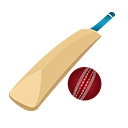A short historical review by Amar Singh, Secretary of the C.C. Morris Cricket Library Committee, a 1954 graduate of Haverford College and member of the Merion Cricket Club and its cricket committee. © 1996, Amar Singh. All rights reserved.
Many colonists in the so-called “Plantation Colonies” of Georgia, Virginia and North and South Carolina played cricket. The earliest record we have come across so far is in the “secret diary” of William Byrd II of Virginia – so-called because it was written in short-hand. He refers to an early morning game with family and friends on the front lawn of his impressive estate, Westover, on the banks of the James River in Virginia on April 25th, 1709. While there are also subsequent references to cricket being played elsewhere, such as Oglethorpe’s colony in Georgia in 1737 and an advertisement in a New York paper for more players in 1739, the first recorded American cricket match per se was in New York in 1751 on the site of what is today the Fulton Fish Market in Manhattan. A team called New York played another described as the London XI ‘according to the London method’ – probably a reference to the 1744 Code which was more strict that the rules governing the contemporary game in England.
There is also evidence that some of George Washington’s troops played a game of “wickets” at Valley Forge in the summer of 1778 – no doubt a Yankee form of the game. A festival match to commemorate an anniversary of the occasion was organized near Wayne’s Woods below the Memorial Arch in the summer of 1993.
Although an encounter took place in Toronto on August 1840, the first international match – anywhere in the world – was between Canada and the United States at the St. George’s Cricket Club in Manhattan (East 31st near First Avenue) on the 24th and 25th of September 1844. The series flourished and then died out. It has been revived in recent years with the 69th encounter, a two day affair, being held on September 2 and 3, 1995 on the beautiful grounds of the Toronto Cricket, Skating and Curling Club, Canada winning comfortably by 128 runs. This competition for the K.A. Auty Trophy has been won by the U.S. 32 times, Canada 27 times and drawn 10 times.
Honors for being the first cricket club probably go to the Union CC of Camden, New Jersey, started around 1840. The most important club in those days was the aforementioned St. George’s CC which soon moved to better grounds across the Hudson in the Elysian Fields at Hoboken, New Jersey, known also as the site of the first recorded professional baseball game between the New York Knickerbockers and the New York Club in 1846. The coach and groundsman was the famous Sam Wright, whose sons, George and Harry were equally adept at baseball. Harry, in fact, went on to manage the first professional baseball team in the United States – the Cincinnati Redstockings (today the Reds). Interestingly, there are three cricket players in the baseball Hall for Fame in Cooperstown, New York – the two Wright brothers and Henry Chadwick, the writer-cricketer who wrote the first Rules of Baseball.
Cricket was played up and down the East Coast and in other locations elsewhere in the as well. However, Philadelphia became the Mecca of the game due to the stimulus provided by the influx of a number of Lancashire and Yorkshire hosiery and mill-workers in the 1840’s. Nonetheless, Jones Wistar, an American, is credited as being the ‘father’ of Philadelphia cricket and it was probably the founding there of the four major cricket clubs of the time that gave the game its biggest fillip- Germantown CC, formerly the Manheim CC(1854), Philadelphia CC (1854), Merion CC (1865) and Belmont CC (1874-1913). These plus the 120 or so other cricket clubs in the Philadelphia area were the crucible of the game until the First World War. It was not surprising that the city produced many of America’s greatest cricketers – including the famous Newhall family (Robert bowled the great W.G. Grace first ball and was immediately presented with his bat which is now in the CC Morris Library at Haverford College), Bart King, perhaps the greatest of them all, who topped the English bowling averages in 1908 while on tour, Percy Clark another fast bowler and Bart’s bowling partner, Henry Scattergood, an outstanding wicket keeper, John Lester the great Haverford College cricketer and Christy Morris another great Haverford and Philadelphia player, to name a few.
1859 saw the arrival of a team from England – the first English tour overseas – under George Parr which included the famous players Tom Hayward, John Wisden, Julius Caeser and John Lillywhite. They played in Canada as well as in New York and Philadelphia and this visit gave rise to the first tour report on cricket away from home. There were subsequent visits from elevens from Australia, Ireland. the West Indies and so on, as well as by teams led by P.F.Warner, Lord Hawke, Ranjitsinghji among others. A Pennsylvania Railroad poster advertising the 1899 visit of Ranji’s Eleven to the Merion Cricket Club, which included McClaren, Jessop and Bosanquet, the master of the ‘googly’ or the ‘bosie’ as it is known in Australia, was recently presented to Stephen Green, Curator of the MCC Library and Museum at Lord’s.
